 Facebook
Facebook
 X
X
 Instagram
Instagram
 TikTok
TikTok
 Youtube
Youtube
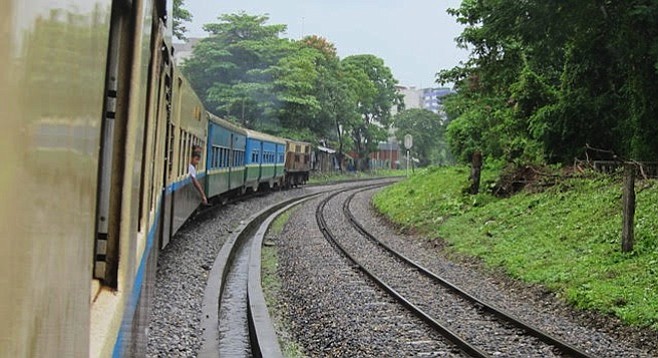
Nyein Sanda works in an office not much larger than a closet in the central train station in Yangon, Myanmar.
His ticket booth on platform 7 hosts a constant stream of tourists looking to ride the Circle Train. The main booths don’t sell tickets for or advertise this train, and so it has gained a cult following of those in the know.
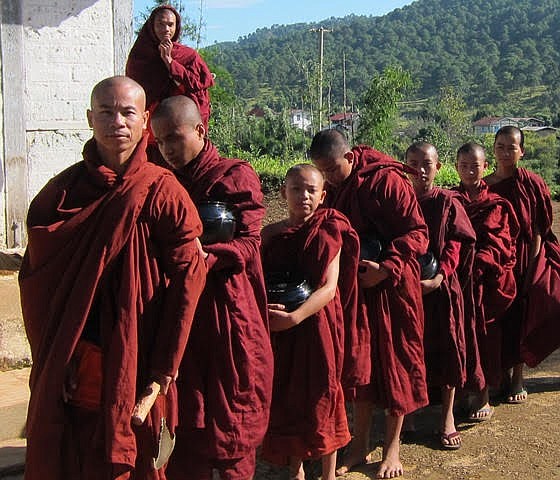
Myanmar has only been open to the outer world for a handful of years, and is just starting to come to terms with a flood of millennial-generation vagabonds aching to see a way of life that has basically evolved inside a fishbowl for centuries. Its geriatric infrastructure and dirt cheap prices have made it one of the hip and cool destinations du jour.
The face of Myanmar's most famous denizen, Nobel Peace Laureate Aung San Suu Kyi, is ubiquitous throughout the country, decorating everything from T-shirts to coffee mugs. Her father, Aung San, who as the unelected but popular leader of British Burma after World War II was assassinated in 1947, is revered equally with his famous daughter.
Yangon maintains its Burmese roots as well as its British colonial heritage, and the circle train is a large part of that image.
In operation since 1954, the circle train is an aging locomotive relic left over from the British occupation that makes a three-hour, 28.5-mile (45.9 km) circumnavigation of the city several times a day on a unique, out-of-date narrow gauge track for about $1 U.S. (Locals negotiate a lower price.) It’s operated by Myanmar Railways and claims a daily ridership of 100,000-150,000.
The locomotives hauling 200 cars circle the city endlessly, each making 39 prescribed stops. The mid-century rail cars are open-air; the revolving fans that line the roof rarely work and do little to relieve the relentless humidity when they do. The seats are hard and straight, and there are not always doors between the cars. Once it gets moving, the aging suspension system will throw you across the aisle if you don’t hang on. The sideways rocking and rolling makes it feel like the train will de-rail at any moment.
Mr. Sanda is a talker and the train’s biggest promoter. “You can see all of Myanmar in three hours” is his mantra. From a map on his desk he painstakingly pointed out each of the 39 stops and gave me a detailed rundown of what I could see at every one. I looked behind me to the dozen or so travelers waiting to buy their tickets and wondered if he would repeat this process with each of them…..he did.
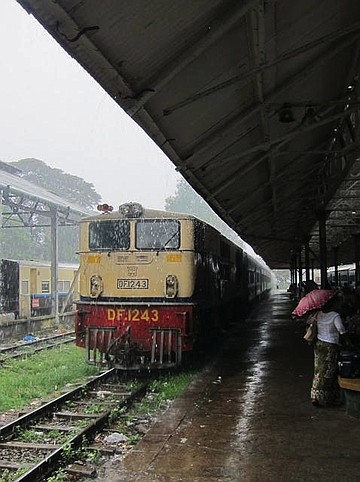
It was the end of rainy season, and the corrugated roof panels of the station did no more than provide a funnel system to dump the monsoon onto the waiting train platforms. One minute it would come down so hard you could not see the next platform, and within minutes, the sun would emerge, then repeat the process over and over, the weather apparently sharing karma with the train.
Some used this public arena to take a rare shower bath, while others relieved themselves in the deluge. Vagrants slept on the cement benches and feral dogs prowled up and down seeking any handouts from the easily marked tourists. It is not the best part of town, and when a local film crew ambushed me with a camera in my face as part of a “Visit Myanmar” commercial, asking me what I thought of their city, I said, “it rocks!”
I got a big thumbs up, and they told me I would be on local evening news. I did not watch it to find out.
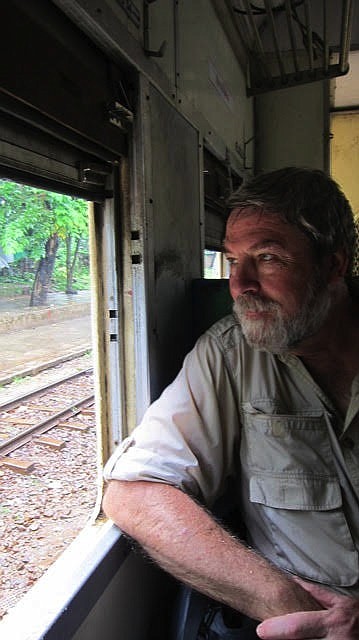
My train announced its coming from far off, creaking and grinding along the track, and when the final brakes brought it to a halt it was like industrial fingernails on a giant blackboard. I boarded behind two teenage monks with pimply faces who kept peeking at me over the next bench and giggling.
We wound through residential neighborhoods, business parks, enormous rice paddies, river canals, cattle farms, and from the choking congestion of the city to the rural countryside, the architecture ranging from colonial chic to shantytown. At a local market I met people from far-off hill tribes, their clans identified by ritual scarring, tattoos and traditional headgear, making a pilgrimage to the big city for delicacies denied them in the high country.
Small private shrines were tucked into the foliage next to the tracks, and when we stopped, young ladies with various goodies balanced on top of their heads would wander past each window hawking their wares. Puddles of spit beetlenut juice, the national “chew” of the country, has dyed most of the ground a bright red – be it a sidewalk or dirt path. Elderly women, called “amah,” smoke sausage-sized, hand-rolled cheroots with two fingers, holding a hollow gourd ashtray under them with the other three digits.
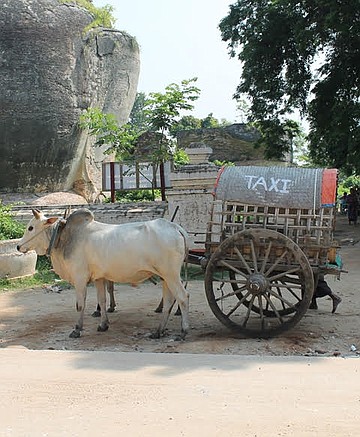
We passed Buddhist monks begging door to door with rice bowls and ancient wooden carts pulled by water buffalo – the local taxi service.
The circle train took me into old Myanmar – Burma/Myanmar, the pocket of Southeast Asia still virtually untouched by the outside world that some remember as Indochina. Without it I would have missed much.
Back at the Yangon station Mr. Sanda was there to greet me. “Sometimes the best journey is just going in a circle,” he said through a huge smile.
Several major air carriers now offer flights into Yangon, among them Cathay Pacific, Malaysia, Vietnam & Laos airlines and China Eastern.
It's best to negotiate a taxi fare at the airport before getting in one, but there's little crime in Yangon and most taxi drivers and honest and reliable, some offering rates for an entire day or week of driving.
The train station is a giant building on Kan Chan Road. Go to platform 7 to buy a ticket for the circle train. They run about every 20 minutes.
Find more travel adventures at James Dorsey's website: jamesdorsey.com.


Nyein Sanda works in an office not much larger than a closet in the central train station in Yangon, Myanmar.
His ticket booth on platform 7 hosts a constant stream of tourists looking to ride the Circle Train. The main booths don’t sell tickets for or advertise this train, and so it has gained a cult following of those in the know.

Myanmar has only been open to the outer world for a handful of years, and is just starting to come to terms with a flood of millennial-generation vagabonds aching to see a way of life that has basically evolved inside a fishbowl for centuries. Its geriatric infrastructure and dirt cheap prices have made it one of the hip and cool destinations du jour.
The face of Myanmar's most famous denizen, Nobel Peace Laureate Aung San Suu Kyi, is ubiquitous throughout the country, decorating everything from T-shirts to coffee mugs. Her father, Aung San, who as the unelected but popular leader of British Burma after World War II was assassinated in 1947, is revered equally with his famous daughter.
Yangon maintains its Burmese roots as well as its British colonial heritage, and the circle train is a large part of that image.
In operation since 1954, the circle train is an aging locomotive relic left over from the British occupation that makes a three-hour, 28.5-mile (45.9 km) circumnavigation of the city several times a day on a unique, out-of-date narrow gauge track for about $1 U.S. (Locals negotiate a lower price.) It’s operated by Myanmar Railways and claims a daily ridership of 100,000-150,000.
The locomotives hauling 200 cars circle the city endlessly, each making 39 prescribed stops. The mid-century rail cars are open-air; the revolving fans that line the roof rarely work and do little to relieve the relentless humidity when they do. The seats are hard and straight, and there are not always doors between the cars. Once it gets moving, the aging suspension system will throw you across the aisle if you don’t hang on. The sideways rocking and rolling makes it feel like the train will de-rail at any moment.
Mr. Sanda is a talker and the train’s biggest promoter. “You can see all of Myanmar in three hours” is his mantra. From a map on his desk he painstakingly pointed out each of the 39 stops and gave me a detailed rundown of what I could see at every one. I looked behind me to the dozen or so travelers waiting to buy their tickets and wondered if he would repeat this process with each of them…..he did.

It was the end of rainy season, and the corrugated roof panels of the station did no more than provide a funnel system to dump the monsoon onto the waiting train platforms. One minute it would come down so hard you could not see the next platform, and within minutes, the sun would emerge, then repeat the process over and over, the weather apparently sharing karma with the train.
Some used this public arena to take a rare shower bath, while others relieved themselves in the deluge. Vagrants slept on the cement benches and feral dogs prowled up and down seeking any handouts from the easily marked tourists. It is not the best part of town, and when a local film crew ambushed me with a camera in my face as part of a “Visit Myanmar” commercial, asking me what I thought of their city, I said, “it rocks!”
I got a big thumbs up, and they told me I would be on local evening news. I did not watch it to find out.

My train announced its coming from far off, creaking and grinding along the track, and when the final brakes brought it to a halt it was like industrial fingernails on a giant blackboard. I boarded behind two teenage monks with pimply faces who kept peeking at me over the next bench and giggling.
We wound through residential neighborhoods, business parks, enormous rice paddies, river canals, cattle farms, and from the choking congestion of the city to the rural countryside, the architecture ranging from colonial chic to shantytown. At a local market I met people from far-off hill tribes, their clans identified by ritual scarring, tattoos and traditional headgear, making a pilgrimage to the big city for delicacies denied them in the high country.
Small private shrines were tucked into the foliage next to the tracks, and when we stopped, young ladies with various goodies balanced on top of their heads would wander past each window hawking their wares. Puddles of spit beetlenut juice, the national “chew” of the country, has dyed most of the ground a bright red – be it a sidewalk or dirt path. Elderly women, called “amah,” smoke sausage-sized, hand-rolled cheroots with two fingers, holding a hollow gourd ashtray under them with the other three digits.

We passed Buddhist monks begging door to door with rice bowls and ancient wooden carts pulled by water buffalo – the local taxi service.
The circle train took me into old Myanmar – Burma/Myanmar, the pocket of Southeast Asia still virtually untouched by the outside world that some remember as Indochina. Without it I would have missed much.
Back at the Yangon station Mr. Sanda was there to greet me. “Sometimes the best journey is just going in a circle,” he said through a huge smile.
Several major air carriers now offer flights into Yangon, among them Cathay Pacific, Malaysia, Vietnam & Laos airlines and China Eastern.
It's best to negotiate a taxi fare at the airport before getting in one, but there's little crime in Yangon and most taxi drivers and honest and reliable, some offering rates for an entire day or week of driving.
The train station is a giant building on Kan Chan Road. Go to platform 7 to buy a ticket for the circle train. They run about every 20 minutes.
Find more travel adventures at James Dorsey's website: jamesdorsey.com.
Comments